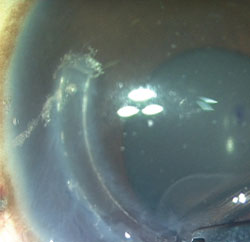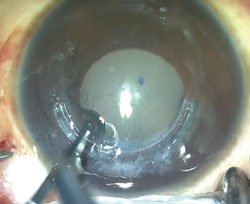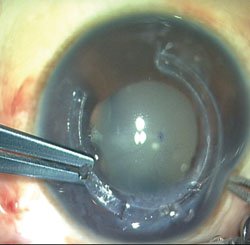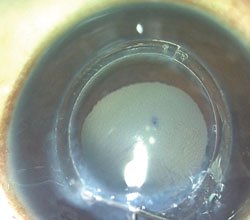Turnaround technique useful for intracorneal ring implantation in eyes with false channel
In cases of insertion difficulty, turning the segment around and inserting it from the opposite direction can prevent complications.
 Amar Agarwal |
Intrastromal corneal ring segments have been used in the past for correction of mild to moderate myopia and for flattening of the cone in patients with keratoconus. Serious complications are not generally associated with intracorneal ring segments.
Intraoperative complications known to be associated with intracorneal rings, such as Intacs (Addition Technology), include shallow placement, perforation into the anterior chamber and difficulty during insertion. Postoperative symptoms can include foreign body sensation, mild discomfort, photophobia and optical aberrations. Nonvisual complications include tunnel deposits and channel haze, which are seen in a large number of cases and are not clinically significant. Other, more serious complications include corneal neovascularization, especially near the incision site, stromal melt around the Intacs, with resultant exposure requiring removal, and channel infections that can spread to involve more of the cornea, sometimes even necessitating a penetrating keratoplasty.
In our experience, too much maneuvering and repeated attempts to insert the segments even in the face of obstruction can lead to complications. Difficult insertion may sometimes result in having to abandon the procedure or to accept a suboptimal positioning of the segments.
Femtosecond laser
Intac segments are implanted with traditional mechanical techniques or with a femtosecond laser. The IntraLase femtosecond laser (Abbott Medical Optics) has the advantage of being more precise regarding the channel size and depth, with less chance of complications such as shallow placement or perforation into the anterior chamber superficially. The femtosecond channel is a continuous, circular 360° channel, thus allowing circumferential movement of the segment. It also has a vertical incision for introducing the ring segment.
When femtosecond channel creation is employed, the Intacs segment is inserted perpendicularly until it reaches the bottom of the incision. It is then turned to be held parallel to, and in the direction of, the tunnel and inserted using short pushes in the direction of the tunnel plane while maintaining the tunnel arc. This generally allows smooth insertion of the Intacs segments. However, difficult insertion may occasionally be experienced at any point along the arc of insertion, especially if the segment, instead of following the IntraLase channel, enters and creates a false plane, with subsequent collapse and loss of the channel plane. Further pushing at this point only leads to the creation of a false channel and a collapse of the IntraLase channel plane.
Turnaround technique
In this column, we describe a turnaround technique for handling such a situation and also describe this technique for placement in case of loss of channel plane for both symmetric and asymmetric Intacs segments. This idea was conceived by Dr. Jacob.
On encountering any difficulty on insertion (Figure 1), instead of trying further pushing movements in the same direction, the segment is removed and turned around to be inserted in the opposite direction through the IntraLase channel (Figure 2). It is then advanced forward as far as possible in the usual manner with forceps. Once it is completely lying within the channel and cannot be moved further forward with the forceps, the second Intacs segment is then used as an instrument for pushing the first one further forward (Figure 3). The arc shape of the second segment makes it the perfect instrument for doing so. This maneuver automatically glides the leading edge of the first segment into the right plane by opening up the IntraLase dissected channel. The first segment is thus pushed forward through the IntraLase channel in the area of false dissection until it has reached the intended site of implantation. The second segment is then manipulated back into its intended site using a reverse Sinskey hook to engage its positioning hole (Figure 4).
 Figure 1. False channel created. |
 Figure 2. Turnaround technique started. The Intacs segment is removed and inserted through the other side. |
 Figure 3. Once the first segment has gone through, the second segment is inserted and used to push the first segment. |
 Figure 4. The first segment is then pulled into place using a reverse Sinskey hook, thus solving the false channel problem. Images: Agarwal A |
False channel
When the Intacs segment enters a plane other than the plane created by the IntraLase, any further pushing leads to the cleavage of a new plane, which is a false channel. The formation of this false channel progressively increases difficulty in insertion of the segment. A wavelike deformity, along with folds radiating from the advancing edge of the segment, is also seen on the cornea and indicates of resistance to further movement of the segment. Further forcible pushing leads to enlargement of the false tract until finally no further forward movement of the Intacs is possible. Creation of the false channel often leads to compaction of the adjacent lamellae and collapse of the IntraLase channel.
Careful examination shows an internal lip in the corneal stroma where the false channel is initiated. This lip is open toward the incision for insertion of Intacs, and it separates the IntraLase channel from the false channel. The lip tends to guide the Intacs segment into the false channel and away from the IntraLase channel. When the turnaround technique is employed for insertion of the segment, the segment approaches the obstruction from the opposite side. It flattens the lip, making the false channel collapse, while guiding the segment from the opposite direction into the right IntraLase dissected plane.
Symmetric, asymmetric segments
With symmetric segments, if it is the second segment that is causing false channel dissection, it is removed and used to push the first segment forward so that this now comes to lie in the area of obstruction. With asymmetric segments, if it is the first segment that has entered a false channel, it is removed and turned around to be inserted from the opposite direction. The second segment is then used as an intra-channel pushing instrument or tool to make the first segment approach its intended site from the opposite direction.
On the other hand, with asymmetric segments, if it is the second segment that is not passing with ease, it is removed and a double-pass turnaround technique is performed. The obstructed segment is removed and is used to push the other asymmetric segment forward, which is then manipulated out through the incision site. This externalized segment is again reintroduced and used to push the segment forward until both eventually come to rest in their respective planned sites.
Conclusion
We found the turnaround technique and the double-pass turnaround technique effective in overcoming a difficult situation that otherwise might have resulted in having to abandon the procedure or accept a suboptimal result.

- Amar Agarwal, MS, FRCS, FRCOphth, is director of Dr. Agarwal’s Eye Hospital and Eye Research Centre. Prof. Agarwal is the author of several books published by SLACK Incorporated, publisher of Ocular Surgery News, including Phaco Nightmares: Conquering Cataract Catastrophes, Bimanual Phaco: Mastering the Phakonit/MICS Technique, Dry Eye: A Practical Guide to Ocular Surface Disorders and Stem Cell Surgery and Presbyopia: A Surgical Textbook. He can be reached at 19 Cathedral Road, Chennai 600 086, India; fax: 91-44-28115871; e-mail: dragarwal@vsnl.com; Web site: www.dragarwal.com. Prof. Agarwal is a consultant for Abbott Medical Optics.
